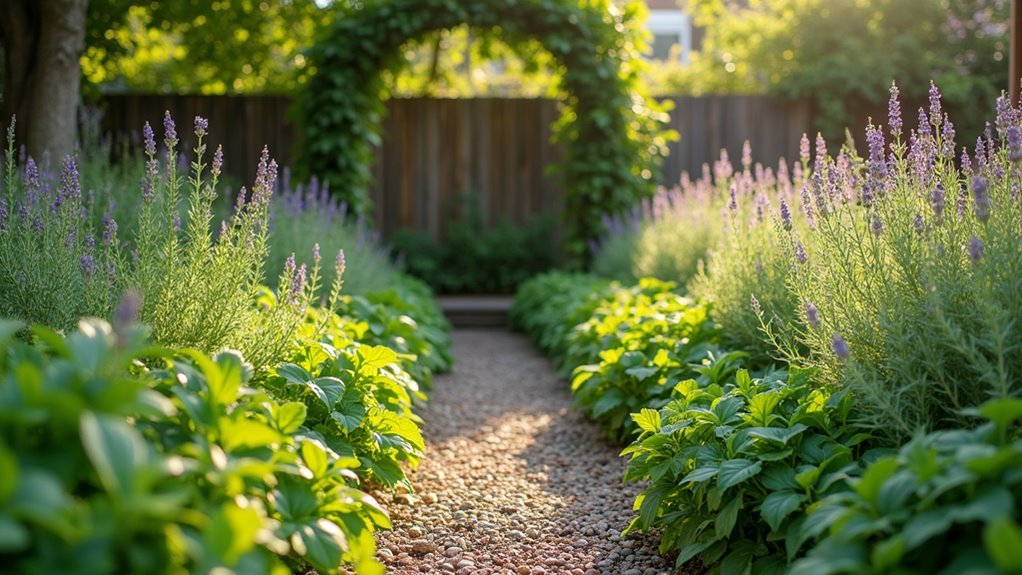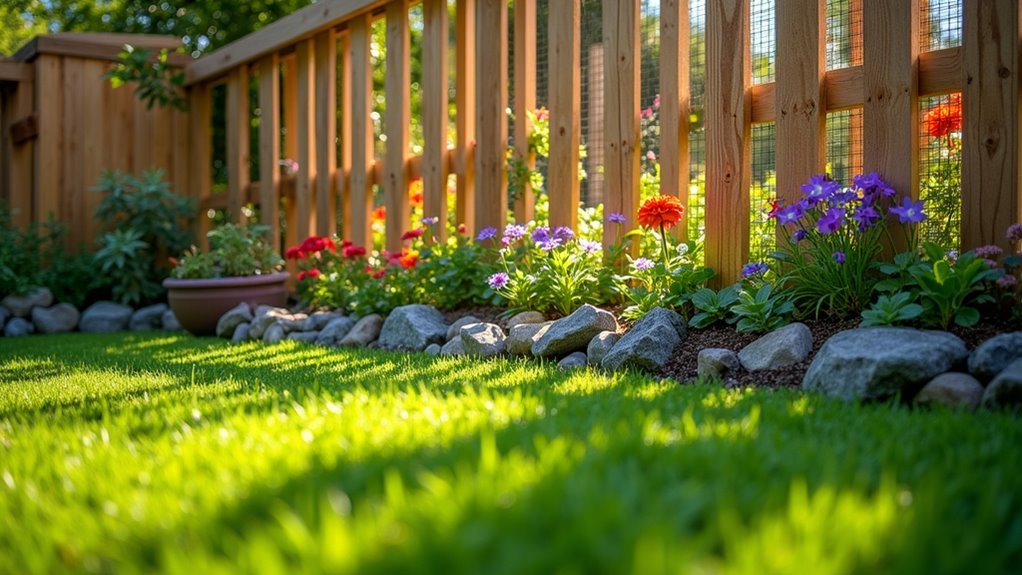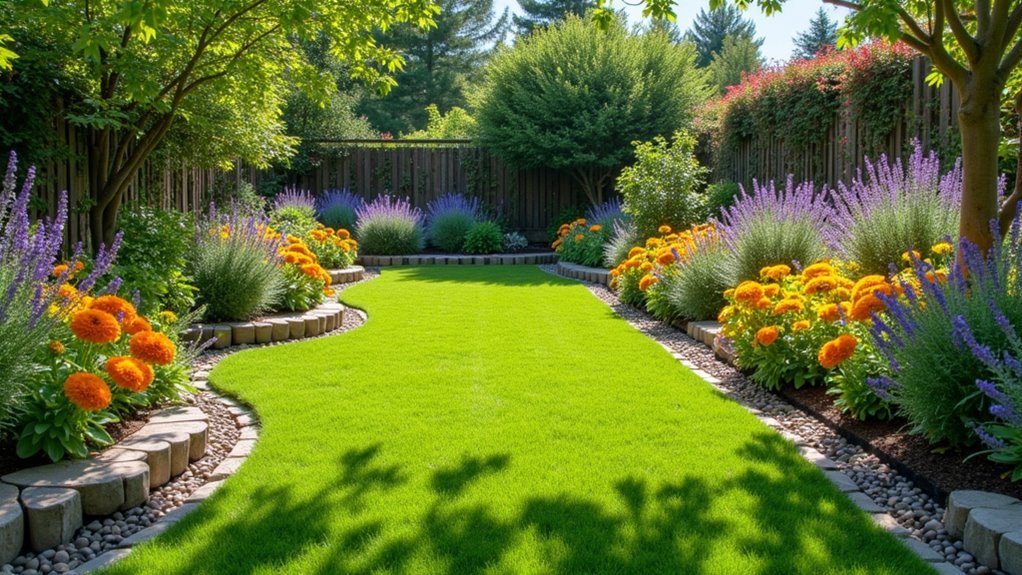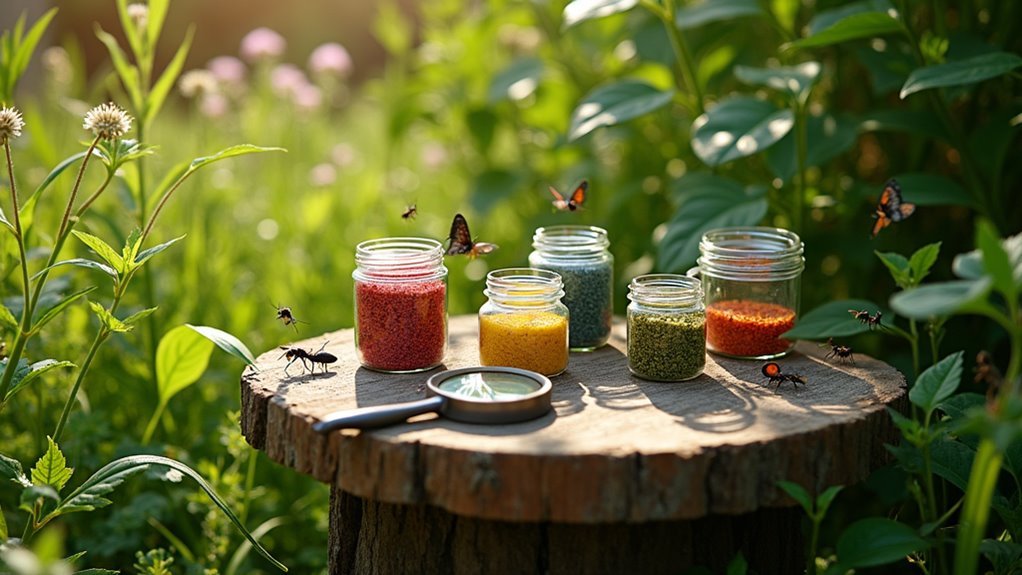You can create effective pet-friendly yard pest barriers using natural plant deterrents like basil, rosemary, and marigolds around your property’s perimeter. Apply food-grade diatomaceous earth near entry points and spray diluted essential oil mixtures (1-2 drops per tablespoon of water) on outdoor surfaces. Mix vinegar with water for a simple deterrent spray, and establish physical barriers using dense shrubs or decorative borders. These non-toxic methods protect your pets while maintaining an effective defense against unwanted insects and pests throughout your outdoor spaces.
Natural Plant-Based Pest Deterrents Safe for Pets

While commercial pest control products often contain harsh chemicals that pose risks to your furry companions, natural plant-based deterrents offer an effective and safe alternative for protecting your yard.
You can plant basil, rosemary, and lavender throughout your landscape to naturally repel mosquitoes and other unwanted insects. These pet-safe plants also add beauty and fragrance to your outdoor space.
Marigolds serve as excellent natural pest deterrents against aphids and nematodes while providing vibrant color.
Essential oils from citronella and geranium can be mixed with water to create effective sprays that keep bugs away.
These natural solutions protect your yard without compromising your pet’s health, making them ideal for any natural pest management strategy.
DIY Non-Toxic Spray Solutions for Yard Perimeters
Beyond incorporating pest-repelling plants into your landscape, you can create powerful homemade spray solutions that form protective barriers around your yard’s perimeter.
These DIY pest control solutions offer effective protection without compromising your pets’ safety.
DIY pest control solutions provide powerful protection for your yard while keeping your beloved pets completely safe from harmful chemicals.
Mix equal parts water and vinegar for a simple deterrent that leaves a fresh garden scent.
For insect control, blend half a cup of ground lemon with one gallon of water.
Create a potent spray by combining one chopped garlic clove, one chopped small onion, and one tablespoon of cayenne powder with a quart of water—let it steep before application.
For aphid control, mix one gallon of water, one tablespoon of vegetable oil, and two tablespoons of liquid dish soap.
Regular application of these natural solution recipes guarantees safe use around pets while maintaining an effective pest barrier.
Physical Barrier Methods to Block Pest Entry Points

You can create effective physical barriers using natural diatomaceous earth, which forms a protective perimeter that pests won’t cross while remaining completely safe for your pets.
Plant-based repellent perimeters offer another excellent barrier method, utilizing specific plants that naturally deter unwanted insects and small animals through their scents and properties.
These physical barrier approaches work continuously without requiring frequent reapplication like sprays, making them low-maintenance solutions for long-term pest control.
Natural Diatomaceous Earth Barriers
Creating an effective pest barrier doesn’t require harsh chemicals when you have food-grade diatomaceous earth at your disposal. This environmentally friendly powder works by dehydrating insects like ants, cockroaches, and fleas on contact, making it an excellent physical deterrent.
Sift diatomaceous earth around entry points including doorways, windowsills, and your yard’s perimeter to block pest access. For carpeted areas, work it deep into fibers where pests commonly appear. Allow the barrier to sit for 24 to 36 hours for maximum effectiveness.
You’ll appreciate that food-grade diatomaceous earth is completely safe for pets and humans, unlike toxic alternatives. Apply it in natural shade to prevent wind dispersal.
Remember to reapply after heavy rain or cleaning to maintain your barrier’s protective qualities.
Plant-Based Repellent Perimeters
When you strategically plant pest-repelling species around your yard’s perimeter, you’ll establish a living barrier that naturally deters unwanted insects while keeping your pets completely safe.
This plant-based repellent approach offers one of the most effective DIY solutions for protecting your outdoor space without toxic chemicals.
Key plants to incorporate:
- Marigolds and lavender – Create colorful borders that repel common garden pests with their natural oils.
- Basil and mint plants – Enhance your garden’s beauty while deterring mosquitoes and flies effectively.
- Dense shrubs or thorny plants – Form physical barriers preventing pest entry points throughout your perimeter.
- Garlic plantings – Provide powerful insect deterrence without compromising pet safety.
Regular maintenance guarantees these barriers stay healthy and continue to keep pests away while maintaining a safe environment for your furry companions.
Pet-Safe Ground Treatments for Crawling Insects
Since crawling insects can quickly overrun your yard and pose threats to both your garden and your family’s outdoor enjoyment, implementing pet-safe ground treatments becomes essential for maintaining a healthy balance.
You can use food-grade diatomaceous earth as a safe, non-toxic pest control method by sifting it onto affected areas. This natural powder disrupts the exoskeletons of crawling insects like ants and roaches without harming your pets.
For ant infestations, sprinkle a mixture of baking soda and powdered sugar in problem areas. The sugar attracts ants while the baking soda eliminates them when ingested.
Additionally, incorporate crushed eggshells or diatomaceous earth around garden plants to create effective barriers against slugs and snails, protecting your garden naturally.
Essential Oil Repellents That Won’t Harm Animals

You can create effective pest repellents using essential oils like cedarwood, lavender, geranium, lemon balm, and tea tree that won’t endanger your pets.
These oils must be properly diluted with water to achieve safe concentrations that protect animals while still deterring mosquitoes, ticks, and other yard pests.
Success depends on understanding which oils work best for specific insects, getting the dilution ratios right, and applying them strategically throughout your outdoor spaces.
Safe Essential Oil Options
Natural essential oils offer pet owners a powerful alternative to chemical-laden pesticides, providing effective pest control without compromising their furry companions’ safety.
You’ll find that specific essential oils create an effective barrier against mosquitoes while keeping your outdoor spaces safe and fun for pets.
When selecting essential oils for outdoor use, consider these proven options:
- Cedarwood oil – Creates a woody, forest-like scent that mosquitoes avoid while pets find pleasant.
- Lavender oil – Produces calming purple aromatherapy that repels insects but relaxes animals.
- Geranium oil – Delivers floral protection with rose-like fragrance that deters pests effectively.
- Proper dilution – Mix 1-2 drops per tablespoon of water for safe application.
Always dilute these essential oils properly in water before application to guarantee your pets’ wellbeing.
Proper Dilution Methods
While essential oils provide excellent pest control benefits, creating the perfect dilution guarantees your homemade repellents remain both effective against mosquitoes and completely safe for your beloved pets.
Follow proper dilution methods by mixing 10-15 drops of cedarwood, lavender, or geranium essential oils per ounce of distilled water. This ratio assures effectiveness while preventing pet irritation.
Before applying your diluted mixture, always perform a patch test on a small area of your pet’s skin to check for sensitivities.
Remember to shake the mixture thoroughly before each use since oil and water naturally separate.
Apply these repellents outdoors rather than in enclosed spaces, allowing your pets to move away from treated areas if they find the scents overwhelming.
Application Techniques Outdoors
Strategic application of essential oil repellents outdoors maximizes their effectiveness while keeping your pets safe from harmful chemicals.
Your DIY approach guarantees you control every ingredient while protecting areas around your home where pests congregate.
Apply your water in a spray bottle containing essential oils using these targeted techniques:
- Garden perimeters – Spray cedarwood and lavender mixtures along flower beds and vegetable gardens where mosquitoes breed.
- Tick hiding spots – Target tall grass, woodpiles, and shaded areas with vinegar-almond oil solutions where ticks lurk.
- Pet resting areas – Treat outdoor furniture, dog houses, and favorite lounging spots with lemon balm blends.
- Entry points – Apply geranium repellent around doors, windows, and deck railings to create protective barriers.
Creating Designated Pest Control Zones Away From Pet Areas
When you establish specific zones in your yard exclusively for pest control treatments, you’ll create a safer environment for your pets while maintaining effective pest management.
These designated zones should be strategically placed away from areas where your pets typically play, eat, or rest.
Install physical barriers like fences, decorative borders, or dense plantings to prevent your pets from wandering into treated areas.
Within these zones, you can use pet-safe pest control methods such as diatomaceous earth or natural botanical sprays that won’t harm your furry friends if they accidentally encounter them.
Mark these areas with clear signage or colorful flags to remind family members about restricted access.
Regular monitoring guarantees treatments remain contained and your pets stay protected from potentially harmful substances.
Beneficial Insects and Natural Predators for Organic Control
You can harness nature’s own pest control system by attracting beneficial insects like ladybugs, lacewings, and parasitic wasps to your yard.
These natural predators will hunt down aphids, caterpillars, and other harmful pests while keeping your space safe for pets.
Creating the right habitat with diverse flowering plants and shelter areas establishes an organic balance that reduces your need for chemical treatments.
Attracting Beneficial Garden Insects
While chemical pesticides can harm both pests and pets, beneficial insects offer a natural solution that protects your garden without compromising your furry friends’ safety.
Attracting beneficial insects requires creating an inviting environment that supports their lifecycle and hunting needs.
Maintaining a pesticide-free environment encourages ladybugs, lacewings, and parasitic wasps to establish themselves in your yard. These natural predators effectively control aphids, caterpillars, and other damaging pests without posing risks to your pets.
Consider these strategies for attracting beneficial insects:
- Plant diverse flowers like dill, fennel, and yarrow to provide nectar sources
- Practice companion planting by pairing pest-deterrent plants with vulnerable crops
- Build insect hotels using bamboo tubes and natural materials
- Leave small areas of bare soil for ground-nesting beneficial species
Natural Predator Habitat Creation
Creating diverse habitats throughout your yard transforms it into a thriving ecosystem where natural predators can flourish and maintain pest populations organically.
Install birdhouses and birdbaths to encourage predatory birds that control beetles and caterpillars. These outdoor structures provide essential resources while keeping your space pet-safe.
Plant flowering herbs like dill and fennel to attract parasitic wasps that naturally eliminate pest insects. Native plants such as daisies and marigolds draw beneficial ladybugs and lacewings, which effectively target aphids without chemical interventions.
Establish a compost pile to create habitat for beneficial nematodes and ground beetles that prey on harmful soil pests like grubs and root maggots.
Avoid chemical pesticides to maintain this delicate balance, allowing your yard’s natural predator network to protect your garden while ensuring your pets’ safety.
Organic Pest Control Balance
Three key strategies form the foundation of effective organic pest control: introducing beneficial insects, supporting natural predators, and creating plant partnerships that work together.
You’ll achieve remarkable results by establishing this natural balance in your yard.
Beneficial insects like ladybugs and lacewings actively hunt aphids and mites, while birds and predatory beetles target common garden nuisances.
Companion planting amplifies these effects by strategically positioning pest-deterring plants alongside vulnerable ones.
Consider these powerful combinations:
- Marigolds surrounding vegetable beds – their scent repels harmful insects while attracting beneficial ones
- Dill and fennel borders – these herbs draw lacewings and parasitic wasps
- Mulched pathways – provide shelter for ground-dwelling predatory beetles
- Native wildflower patches – create permanent habitats for natural predators year-round
This balanced approach eliminates pests while keeping your pets safe.
Homemade Traps and Baits With Pet Safety in Mind
When you’re dealing with yard pests but want to keep your furry friends safe, homemade traps and baits offer an effective solution that won’t put your pets at risk.
These effective DIY methods target specific pests without creating hazards for your animals.
Create a fruit fly trap using apple cider vinegar, liquid dish soap, and plastic wrap.
For ants, mix equal parts baking soda and powdered sugar – the sugar attracts them while baking soda disrupts their digestive systems.
Build silverfish traps with flour in straight-sided glasses and tape climbing paths.
These safe for pets solutions include flea deterrent sprays combining dish soap, white vinegar, and warm water.
For tick prevention, blend white vinegar, water, and almond oil to create natural barriers around pet areas.
Maintenance Practices to Prevent Pest Infestations
Five essential maintenance practices form the backbone of effective pest prevention while keeping your pets safe in the yard.
These proactive steps create an inhospitable environment for unwanted insects and rodents without compromising your furry friends’ health.
- Weekly debris cleanup – Remove fallen leaves, pet waste, and standing water from gutters or containers where mosquitoes breed and pests hide.
- Secure fence inspections – Check for cracks, gaps, or loose boards monthly, sealing openings that allow pests to enter your yard.
- Airtight food storage – Store pet food in sealed containers and immediately clean spills that attract ants and other insects.
- Strategic herb planting – Plant basil and lavender around play areas to naturally repel mosquitoes while adding pleasant garden aromatics.
Seasonal Yard Care Strategies for Year-Round Protection
As seasons change, your pest prevention strategy must adapt to address the unique challenges each time of year brings to your pet-friendly yard.
| Season | Primary Actions | Natural Solutions | Key Focus Areas |
|---|---|---|---|
| Spring/Summer | Apply diatomaceous earth around garden beds | Create natural barriers against fleas/ticks | Pet play areas and perimeter |
| Fall | Clean fallen leaves and debris | Homemade garlic and cayenne spray | Yard perimeter and hiding spots |
| Winter | Manage mulch and compost piles | Provide pet shelter from cold | Rodent prevention areas |
| Year-Round | Regularly inspect and maintain fences/barriers | Consistent monitor and treat standing water | All potential entry points |
Each season demands specific attention to different pest threats while maintaining your pets’ safety and comfort throughout the year.
Frequently Asked Questions
What DIY Pest Control Is Safe for Dogs?
You can use water-vinegar solutions for ants, dish soap sprays for aphids, essential oils like cedarwood for mosquitoes, and baking soda-sugar mixtures for ants when placed away from your dog’s reach.
How Do I Make My Yard Pet Friendly?
Choose non-toxic plants like marigolds, install six-foot fencing, and designate specific play areas. Use natural pest barriers such as crushed eggshells around plants. Regularly inspect your yard for hazards to maintain safety.
Is Bug Stop Home Barrier Safe for Pets?
Bug Stop Home Barrier’s designed with pet safety in mind, using less harmful ingredients than traditional pesticides. You should still keep pets away from treated areas until it’s dried completely for maximum safety.
How Do You Get Rid of Bugs Without Harming Pets?
You can eliminate bugs safely by sprinkling food-grade diatomaceous earth on carpets, spraying vinegar-water solutions, using baking soda-sugar ant bait, applying soapy flea sprays, and planting natural repellent herbs like basil.
In Summary
You’ve now got a thorough toolkit for creating effective pest barriers that keep your furry friends safe. By combining natural deterrents, physical barriers, and beneficial insects, you’ll maintain a healthy yard without toxic chemicals. Remember that consistency is key—regular maintenance and seasonal adjustments will guarantee your pet-friendly pest control methods remain effective year-round. Your pets can now enjoy the yard while you enjoy peace of mind.





Leave a Reply